Mammoth Cave National Park and other cave systems are part of a limestone belt that defines Kentucky’s landscape with its gently sloping bluegrass valleys. This geography made way for Kentucky to become the thoroughbred horse capital of the world and drive an economy built around events such as the Kentucky Derby. Beneath this limestone bedrock, a water supply often ranked No. 1 for water quality in the United States fuels well-known and developing dive sites that are surprisingly blue.
Four distinct dive sites are within a few hours of driving from Louisville. Two are reservoirs in natural areas, and the others are limestone quarries that reflect the brilliant blue water. Tiny calcium carbonate crystals from the limestone walls float in the water, giving it unusual hues.
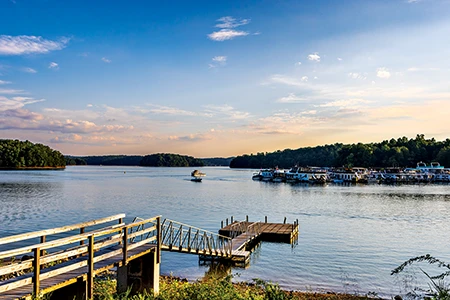
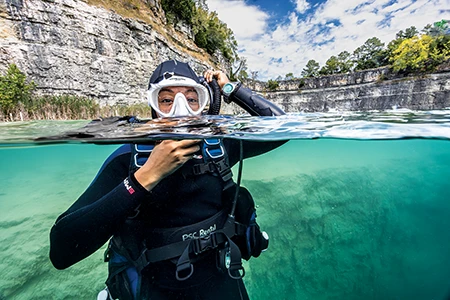
Le FRP LaGrange Quarry is a popular training destination outside of Louisville. The Kentucky Department of Fish and Wildlife Resources and the Greenbo Recreation Association created Greenbo Lake State Resort Park east of Lexington to expand outdoor adventure in the state. Laurel River Lake in southeastern Kentucky is a local favorite as one of the cleanest lakes.
The state’s most prominent dive site celebrates 30 years of operation as a dive destination this year. Divers line up early to visit Pennyroyal Scuba Center’s Blue Springs Park in Hopkinsville, just over two hours south of Louisville. Hopkinsville is a small town that promotes itself as the Batter Capital of the World and is known for its specialty: soft red winter wheat used in Krusteaz, Cracker Barrel, and Ghirardelli products.
Diving is a significant contributor to Hopkinsville tourism as divers seek out Blue Springs Park for weekend getaways. Recreational divers camp and celebrate events such as Women’s Dive Day and Halloween, which features zombie dives. Technical divers practice coldwater circuits in the deep side of the quarry. While the attractions steal the attention, rugged limestone walls tower impressively from the entrance to the sides and down to the bottom section.
The home state of boxer Muhammad Ali, Kentucky is more than just bluegrass music — there is a surprising mix of bourbon trails, outdoor adventures, and complex history, along with the dive sites.
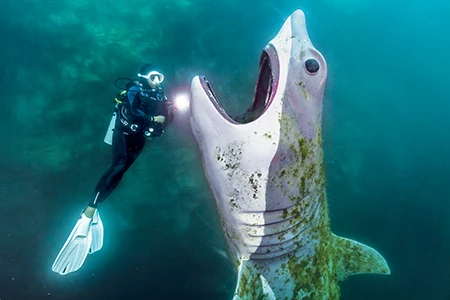
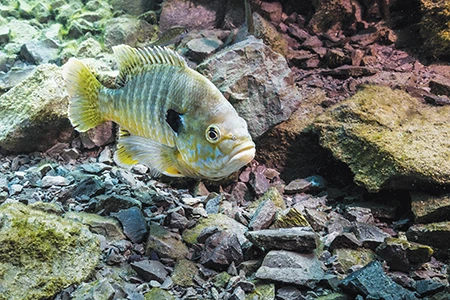
Blue Springs Park
After this limestone quarry closed to mining in 1986, retired coal miner Dennis Tapp purchased the property to develop it into an accessible dive site. When he first dived the site in 1992, water had yet to stop filling the quarry. Its deepest point was 47 feet (14 meters), but it eventually filled to 120 feet (37 m). Pennyroyal Scuba Center opened in 1994.
Tapp’s son, retired paramedic Kris Tapp, and his wife, Christa, kept alive the dream of a publicly accessible destination dive site by taking over the operations. Kris became hooked on diving when he first dived Cerulean, a nearby quarry now closed for diving. They continue developing the facility by adding features to the more than 40 underwater attractions supported by an infrastructure that makes diving a fun community activity. Numerous picnic tables surround the dive entrance, providing ample setup space for shore entry or giant strides into the quarry.
A recent addition is a great white shark sculpture named Penny that they recovered from the flooded Opry Mills Mall, formerly Opryland, in Nashville, Tennessee. Christa painted its likeness using paints approved for aquatic environments.
Staff from regional dive shops visit Pennyroyal Scuba Center for their training and dive activities. Industry pioneer Saralynn Turner, who founded Easy Divers in 1983 in Memphis, Tennessee, created the lighthouse navigation course prominently featured in the quarry’s shallow side. She involved the community in the course’s development by having each lighthouse sponsored and painted and is remembered for sharing what she loved.
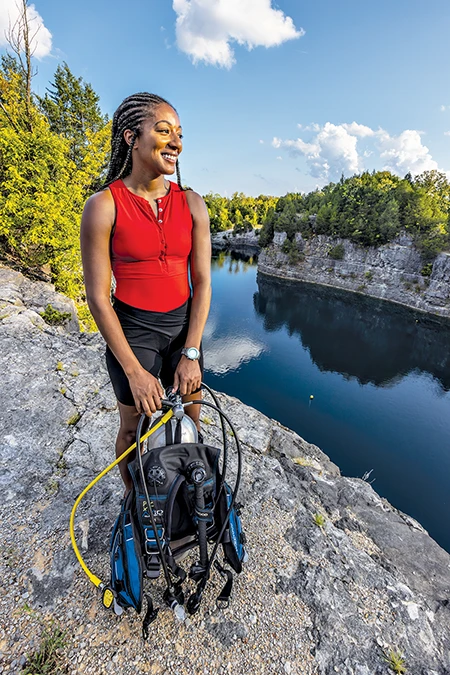
The dozens of other sunken attractions are too numerous to list on their dive map, which adds to the joy of discovery. Highlights include boats, phone booths, and a basketball hoop with supplied basketballs of varying buoyancy. More than a series of artifacts, the underwater playground at Pennyroyal is a curated tribute to local history with a dash of fun.
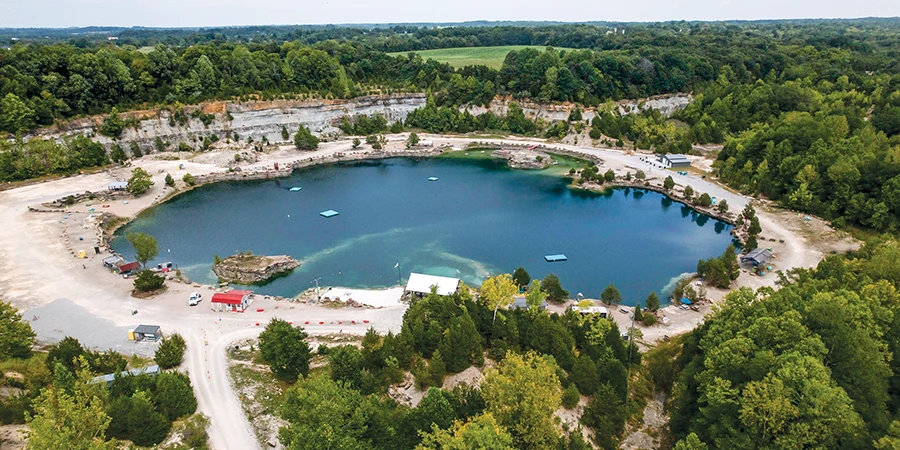
FRP LaGrange Quarry
At 7 acres (2.8 hectares), this warm blue quarry near Louisville is big enough for enjoying a recreational day of diving. At nearly 55 feet (17 m) deep, this site features many sunken attractions seen at other quarries, including boats and a phone booth.
As a prominent swimming attraction, this popular, privately owned quarry is shallow, and divers should make a reservation online in advance. Although children are prohibited from swimming here, they are allowed to dive. No fills or equipment are available at this site, but local dive shops provide access to scuba rentals.
Laurel River Lake
The dam and a cove to the left of the Craigs Creek boat ramp provide scuba access to a clear lake filled with bass and bluegills. Divers can explore the granite rocks, especially near the Holly Bay Beach at the dam, where depths reach 80 feet (24 m).
The Appalachian foothills surround this quiet lake in the Daniel Boone National Forest west of Corbin, Kentucky. Underwater trees tower above you and make for a leisurely exploration. The inlet next to the boat ramp is deepest at its mouth and offers plenty of natural landscape to observe along the shore.
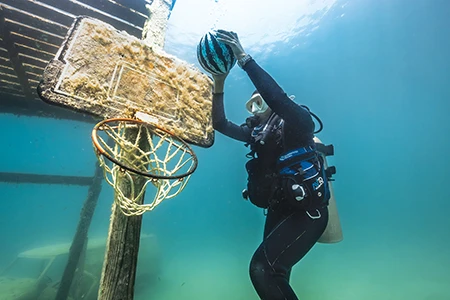
Comment plonger ici ?
Conditions : Dive sites are open from May to November, with Labor Day marking a seasonal change. During summer, 5mm wetsuits are usually comfortable in all destinations, while a 3mm wetsuit is often sufficient at the warmer FRP LaGrange Quarry. A drysuit is best for the stiff thermoclines below 50 feet (15 m). The visibility is best in the morning and can be up to 50 feet (15 m) in the quarries; 5 to 30 feet (1.5 to 9 m) is more common in reservoirs.
Equipment: Louisville dive shops offer rental equipment, and Pennyroyal Scuba Center is a full-service dive center. Schedule visits online for quarries and bring dive flags for reservoirs.
En savoir plus
Learn more about Kentucky’s dive spots in these videos.
© Alert Diver – Q4 2024